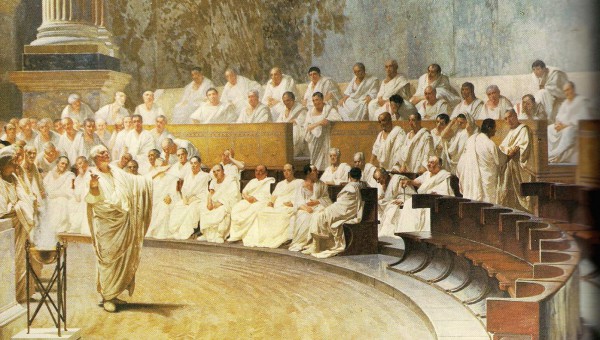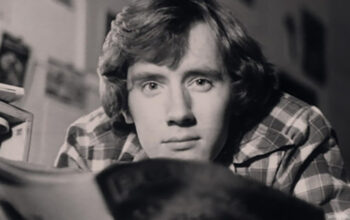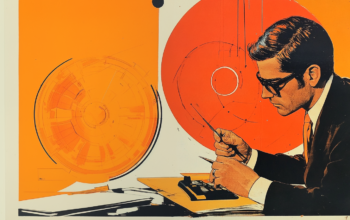Appreciating the Classics
 September 2004
September 2004
It is assumed in our culture that latest is best. The notion probably got its start thanks to the prominence of science and technology, two fields in which progress is a fact. But the belief has taken over the American mindset to the extent that all products of our culture adhere to that standard.
Film, music, television, literature, fashion, education, family style, politics, philosophy, and even religion must all keep up to date in order to seem credible. Consequently, any cultural product that is not the most recent addition is considered negligible and discarded.
This consequence is regrettable because culture from the past, as is the case with science and technology, is necessary to build new and progressive cultural products and keeping it in our minds is integral to future success. It is also true that cultural products like film, music, and literature are based in ideas and, as such, they are able to stand on their own—they are rewarding in themselves no matter what age they are received in. The secret that the open-minded will discover is that culture from the past has much more substance and can be much more enjoyable than that of today and we are lucky that it has been maintained for our pleasure as well as our edification.
To say that older works are better than modern works is not to say that the grass is always greener on the other side or the past is always golden. It is true because societies change and a society’s form dictates what culture it produces. It just so happens that societies of the past were stronger, more innovative, and nobler than ours is today and the quality of the music, storytelling, and art reflects that.
What has changed? Simply put, we are more capable today than we were 500 years ago or even 50 years ago. Our techne has developed so much that we can do things that were unimaginable just 20 years ago and the trend shows no signs of slowing. This improvement on technique is nearly universal. It spans medical and scientific fields and carries over into business and economics.
Techniques in the arts have improved as well. A comparison between the most advanced form of visual art in 1500 and that of today makes the point clear. Painting was as powerful an art as could be created in the Renaissance. It was somewhat simple, required the skill of an artisan, but everyone knew what was involved in the process and, since the product was solid and tangible, few could be blown away by the finished product.
The forefront of visual art these days features a number of varied media, but 3-D computer animation may be the most compelling example. It is as complex as can be imagined especially for those who are not involved with computer programming, which is nearly all of the population. Its complexity and intangibility can be proven by the wonder with which people gaze at the latest film of the genre—we are truly blown away by it.
With 3-D animation, we have been able to recreate the natural world, human expressions, and moods with no noticeable flaws whatever, a feat that even Michelangelo or Leonardo could not post on his resume. We have improved the techniques of those masters’ arts as well—painting, music, and storytelling have all been perfected or at least nearly perfected as we have honed in on every aspect of the art forms and uncompromisingly fine-tuned the way each are delivered.
We have uncovered human psychology and discovered what the arts do to us mentally and better targeted those faculties. Not only is the method infinitely powerful, but so too is the content infinitely relevant and engrossing. In this way, the art does not have to be filled with dazzling special effects to draw us in more convincingly. Altogether, the modern arts are more skillful, more visually appealing, more engaging (addictive), more realistic, more fantastic, and more enlivening than ever before; they are perfectly crafted pleasure pills that we just cannot get enough of.
But while a movie from 1939 (not to mention a play acted in 1639) has absolutely no power to engage an audience compared to a 2004 blockbuster, it cannot be said that it lacks merit completely. The Wizard of Oz, with its glowing colors, was the first of its kind and no doubt dazzled contemporary moviegoers like The Incredibles does today. And it was for audiences of all ages, not just children, as cutting-edge technique interests all people in a given society.
The improvements on technique that impressed audiences 70 years ago are no less significant today even though we have taken them for granted, moving past them in favor of new enhancements. Film presented in full color is still an amazing thing even though we have no black and white to compare it to. For that matter, moving pictures—even the black and white kinds—are themselves an amazing feat even though we are not stuck in the mode of paintings.
When an old film uses a good 30 seconds to open a scene with a long, drawn-out pan into a crowded, bustling marketplace, the modern audience falls directly asleep. They do not realize all that is going on. They forget the technology and vision it takes to first sit us atop such a scene, seemingly floating, and then gradually descend us into the crowd. It is an amazing feat even if the ride at Six Flags does the same thing much faster and over a greater distance. Having the latter should not relegate the significance of the former—both are equally fascinating.
Good art moves the audience from where they are to a new and better place. To do this, the artist must first understand his audience and make a connection where they are at the time. Past art connected to past audiences, and so, to appreciate past art, one must place oneself in that period as far as expectations and desires go. He must understand life the way people did then and, once he does, their arts suddenly become enjoyable. What enraptured them will enrapture him as well.
One does this in order to enjoy the technique of classical art as examined above, but technique is only half of art. The ideas behind the art play as sizeable a role as technique does and too they can be much more rewarding. Technique keeps us on the edge of our seats while we are witnessing it, but the idea is what makes us float out of the theater and keeps the visions in our heads for days. The idea is the new and better place the art takes us and that is really the point of the art. So, in order to fully enjoy the art of the past, one must prepare for the ideas as well.
This means that one must place himself in a frame of mind that not only neglects modern technological advances, but one that neglects modern cultural advances in total. That includes social and ethical standards that have dear, personal significance. One must find out how people talked and acted, what major political and social structures were in place, what kind of pace life was lived at, and what was important to the people of the age concerned.
That is, of course, the most crucial aspect of fitting into another culture’s shoes—grasping what it is that the other culture aims for. It is also the most difficult aspect because it involves letting go of our aims or of what we feel is important. The older goals might well be outdated and quite possibly conflict with our own goals meaning that we would have to defeat ourselves somewhat to witness an older work. While it is jarring to think of technology the way that we did in the past, it can feel unethical and corrupt to place oneself in the complete mindset of past cultures.
For example, to appreciate one of Shakespeare’s plays, one must get used to a different way of speaking and probably dressing, and other customs, but one must also get used to the notion of kings and queens and the devotion that their subjects would have for them. In Shakespeare’s time, monarchy was a fact. We laugh at the prospect of serving a leader as they did then and cannot easily relate to the mentality or behaviors of the characters at times. They just don’t seem right and are rather ridiculous instead. This is why not a few Shakespearean adaptations include altered content (in addition to language and dress) so as to appeal to a new temperament.
One will rightly question whether a play is worth taking in if the main characters are foolish and maintain ridiculous ideals. Theater, like all storytelling, is based in the decisions that the protagonist must make when faced with obstacles. If the protagonist is a fool, then, we cannot be inspired by his decisions and the story as a whole seems worthless.
But what makes a character foolish is not what clothes he wears in the first act or whether he aims to blindly please his ruler at any cost, it is making a decision somewhere along the line that is inappropriate for his person or that contradicts his aims. If he is able to make decisions that not only fulfill his ambitions, but does so in inventive and surprising ways, he is a hero. We love to watch a protagonist face challenges and imagine what we would do in such a situation. If the hero can show us a way out of troubling predicaments in ways that we did not think of, we are thoroughly entertained. The movement from his starting point to his final destination given the obstacles he faces is the idea of the play and that very important component is retrievable from all good art no matter who the protagonist is and what predicaments he his faced with.
If we are able assume the virtue in the aims and ambitions of past cultures and put ourselves in the shoes of past societies, we will find that the ideas presented by the classics are rich and plentiful. That is because the aims and ambitions of past cultures offer much more enthralling challenges than those of today. As explained above, ours is an age of great technical expertise. One might say that we have near infinite freedom in what we can do. The result of this is complex and cannot be fully examined here. It will suffice to say that our freedom has redirected our focus from something above us to our own plane, the social realm, to the bringers of our freedom.
Ours is doubtless a fascinating plane, filled with intrigue and mystery, and art that reflects this is quite engaging. But the art is limited in its scope as it lacks the upward mobility. When we are as high as it gets, the ceiling constricts and the art cannot carry us to a new and better place. The result is art that has energy and drive with nowhere to go. It promises self-actualization, but inevitably must fall away from it.
With freedom and power not taken for granted, art of the past acknowledges the need for growth and upward motion, and with it opens the ceiling to a seemingly limitless universe of possibility. The symbol most used to represent this possibility, God, with the upward motion represented by religion, was the centerpiece of nearly all classic works.
In our ‘enlightened’ age, we have discarded religion and especially Christianity as either blind following led by tyrannous rule or quaint emotional sustenance for the masses, neither of which demand much respect. But religion contains some phenomenal ideas. The one that anchors the Christian faith—that God manifested Himself into man through Jesus to become half man and half God—is a concept pregnant with inspiration and awe. What is it to be man? To be God? What was God’s message in becoming both? What is the role of miracle? What is the significance of life?
It cannot be said that God is absent from the movies and philosophies of modern society, but He definitely has changed roles from the all-pervasive and all-encompassing goal of culture that He was before the 20C. He has been relocated to a humbler station from where we can summon Him whenever we so choose, for instance, when we want to reference something that is mystical or out of our control. Christianity’s God has been rejected and replaced by a more Eastern concept where each person has his own god that reflects the personality and morals of each individual. Altogether, religion has become some mystical defense of one’s personal behavior. God today is a tool that helps us construct our own social standing and offers no more ideas than might a mysterious glowing briefcase that no one knows the contents of.
Classical music illustrates best. It is probably the most difficult of the classic arts to appreciate, mainly due to the power of modern music, which is simply enthralling. Putting on the latest hit or the next big anthem is like tuning into life with the kind of energy it brings. Its rhythm makes us want to see and be seen, the instrumentation links us to the new century, the vocals and lyrics radiate our concerns and desires, and the melody wraps it all up, amplifying the connection we feel between one another. It is all that an art should be.
Modern music’s format is relatively simple. It presents an idea in verse form, then it reiterates that verse by repeating it or going over it again with slightly altered lyrics. Getting the point by now, the audience needs more and so the song moves into a different mode, the chorus, which has many similarities to the verse, but stands out nonetheless. For the sake of emphasis, after the chorus, the song returns to the verse and follows it up again with another chorus. The audience gets this point as well after the second go-through, and so the song introduces yet another component, the bridge. It is usually more distinct than the others and nearly represents a full departure from the nest song. But it progresses and carries us far enough that we barely lose sight of that nest before it returns us and we are home again to enjoy another verse and chorus.
We go on this adventure almost every time we turn on the mp3 player. It is so popular because it works. It takes us on a trip and draws out the melodies so that each part is fully realized without being exhausted. But there are other ways to make full use of melodies. Some require different formats to sound good and so limiting music to this good format may be comforting, but it denies us music’s entirety.
Classical music knows no formulas when it comes to format and that is one reason why it is so difficult to get in to. None of it is familiar like modern music is so one cannot know what to expect when he listens to the old works. This formula-free style is also how classical music can express the number of feelings and themes that it does—a number much greater than that of modern music. Classical music is nearly limitless in its ability to convey mood, which is in large part why it fits so well in movies even long after classical music has disappeared from the purely musical arena.
The critic will suggest that it does not matter how flexible the music is as long as it does not address the feelings and themes that are important today. Beethoven’s countless masterpieces may be perfect in form, but they mean nothing because they cannot get a crowd jumping at the local discotheque and they cannot turn one’s desires into action on the dance floor.
Music is a very social art. By its auditory nature, it can be experienced by many at once so that all in earshot are connected. Song is also an embellishment of our most basic form of communication, talking, its intonations reflecting and amplifying those of a person speaking. As speech is a most commanding form of social interaction, it connects music to the social in ways no other art can.
As such, music fits in a social age like ours better than any other art does. We simply love music and fit our lives around the CDs and mp3s we buy and the musicians who produce the art for us. This also obliges music to lodge itself in the social so that its feeling and substance embodies the intricacies of our daily interactions and personal relationships as opposed to the struggle with our own imperfection, for instance, or the presence of the Trinity.
But music can represent those other facets of life in addition to the more natural, social ones. When it does, the music rewards the listener to a much greater degree. The audience feels a sense of resolution that the motionless contemporary music fails to offer, and, by virtue of the challenging predicament classical content presents, resolution is much more complete.
By nature, the classics must last. That is to say that they are enjoyable beyond the age that gives them birth. What makes them accessible in an age with different customs and superficial activities is their ability to detach themselves from those material constructs. Art that is not dependent on style of dress, manners, and even the language used is art that will continue to enliven the spirit for ages to come. Perhaps it is our familiarity with modern arts, those that are so dependent on material constructs, that makes it difficult to appreciate the classics. We are used to seeing and hearing about our superficial things. The more our society changes, the more we will realize that the thrill we got from a movie or song 5 years ago does not necessarily last and we will begin to look for something that will. The classics will be waiting patiently.



